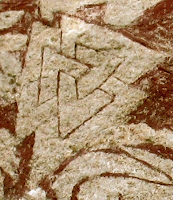It is a symbol consisting of three interlocking triangles, which appear in a unicursal and tricural form. There are various theories proposed for its significance. The name Valknut is a modern invention which describes the symbol. It was not used when the symbol was originally used.
Authentically the triangles are joined in two ways:
Unicursal:
This symbol has been found in unicursal form on many stones such as the 7th c Tängelgarda stone from
In chapter 17 of the 13th c Prose Edda book Skáldskaparmál there is the following description of the heart of the Jötunn Hrungnir.
(a giant who challenges the gods);
"Hrungnir had a heart that was famous. It was made of hard stone with three sharp-pointed corners just like the carved symbol hrungnishjarta, Hrungnir's Heart."
The Valknut occurs in a central and predominant position on the Stora Hammars I Stone.
In the above photograph Odin is shown riding Sleipnir (the eight legged horse and son of Loki from a rather nefarious liasison with a giant’s stallion Svadilfari. The Valknuts are drawn beneath Sleipnir. (Photograph of the Tängelgarda Stone.)
In one of her theories, she cites that beside a figure of Odin on his horse, which is shown on several memorial stones, there is a knot shown which is referred to as the valknut, and is related to the triskele. It is thought to symbolise the power to bind and unbind by the gods. This is mentioned in the poems and in other sources. Odin was attributed with the power to lay ‘bonds’ upon the mind. With this men became helpless when in battle. He could loosen these bonds of fear by the gifts of inspiration , madness in battle (berserkers) and intoxication.
Due to the fact that the symbol (valknuter) is inscribed on stones with Odin and also on burial gifts (Oseberg ship burial) it has been theorised that the symbol may have been associated with religious practices associated with death.






No comments:
Post a Comment